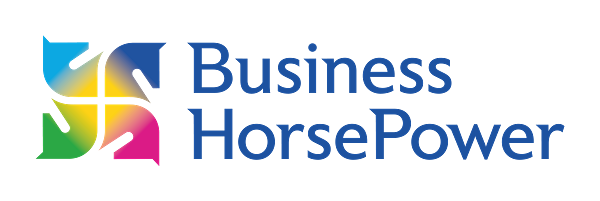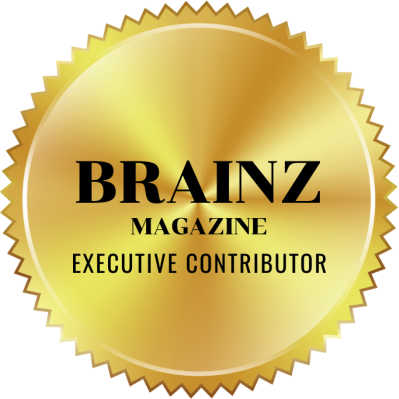
by Julia Felton | Nov 8, 2012
According to research cited in Management Today, only one in every 20 bosses (5%) is a good leader. So for every company that has 20 bosses (your average 200-300 employee firm), only one of them is likely to be a good boss. For a public sector body with say 5,000 employees, it may have 25 good bosses. Puts things into perspective wouldn’t you say?
How on earth does this happen in today’s world?. In John Maxwell’s experience most people stop growing when they reach their 20’s. Rarely do you find a person committed to a personal growth plan into their 30’s, 40’s or beyond. I know that when I worked in the corporate world bosses were so busy working that they rarely had time to develop themselves. And yet the irony is that great leaders never get to the point where their influence has maxed out. They always have unreached potential waiting to be fulfilled. In leadership, how far you go depends on how much you grow. Your growth as a leader is within your control; you can do something about it. You’ll grow the most when you know the most about how the process of personal development happens.
There are three basic laws of personal growth:
1) The Law of Intentionality: Growth Doesn’t Just Happen
Seldom do we lack access to information that can help us grow, but rarely do we apply the resources at our disposal. Put simply, knowing isn’t the same as growing. Whilst old age may happen automatically, growth doesn’t necessarily come with experience. This reminds me of the adage:
To Know and Not To Do is Not Yet To Know
In order to grow to our potential, we have to discard the mistaken beliefs that prevent us from moving forward. Two such beliefs are:
- that failure is fatal
- that we don’t have time right now to pursue a growth plan.
For starters, failing doesn’t mean that someone is a failure. Mistakes are an inescapable part of life, and failures often teach us lessons that we could never learn otherwise. Indeed, failures are steppingstones to success. With respect to time, the longer we intend to do something without taking action, the greater the odds that we will never do it. Time is the one resource we cannot recapture once it’s lost; there’s no way to make up for months and years of neglecting personal development.
2) The Law of Awareness: You Must Know Yourself to Grow Yourself
Personal growth isn’t a one-size-fits-all strategy for self-improvement. For personal growth to be beneficial, and not a waste of energy, it must be suited to your unique strengths and particular temperament. Not everyone shares the same learning style: what works for one person may be completely inappropriate for another. In addition, personal growth requires you to identify your purpose in life. Unless you’re clear where you’re headed, you won’t know which ways to grow. On the other hand, once you have a definite vision in mind, you can begin to develop the specific set of skills needed to accomplish it. Knowing your Talent Dynamic profile provides great insight into the best way for you to grow, a way that matches your learning style and uses your gifts to their best ability.
3) The Law of Consistency: Motivation Gets You Going, Discipline Keeps You Growing
Anyone who has successfully lost weight through regular exercise can tell you that there were days when they didn’t feel like going to the gym. All of the excitement about getting in shape dissipates at 5:00 am when the alarm clock rudely reminds you to get out of bed for a morning workout. To develop the discipline to keep growing, we must constantly remind ourselves why personal development means so much to us. As Simon Sinek reminds us – we must have a great reason why because unless we have clarity on Why we are doing something we will never maintain the motivation and discipline to continue when times get tough (and they inevitably will).
To get where you want to go in life, personal growth cannot be overlooked, postponed, or taken for granted. Your development requires intentionality, focus and accountability. It also requires a plan. If you would like help developing your plan sign up for one of my complimentary Grab The Reins – Lead Your Life Discovery Sessions where we will uncover what is holding you back from reaching your full potential.

by Julia Felton | Oct 28, 2012
‘Before you are a leader success is all about growing yourself.
When you become a leader, success is all about growing others.’ Jack Welch
A recent survey conducted by Emergentics International revealed that Leadership development is the number one priority of HR and organizational development leaders, with 25% of respondents putting it at the top of their priority list. With organizations needing to meet ever-higher financial goals and growth targets, the emphasis on people development provides a window into the way companies are seeing their ability to rise to the top.
The emphasis on talent development and management over competencies like innovation and tactical elements like metrics points to a realization that positive advancements in organizations must start with people. The second highest response for organizational priority was employee engagement, at 22%.
So what is leadership? The Oxford Paperback Dictionary defines a leader as ‘one whose example is followed’. Leadership is that elusive quality that companies are looking for and yet, in my opinion, is so often lacking in organisations. Given the multitude of companies offering leadership training and the circa £3billion spent on external training annually in the UK, how come our companies are not some of the best performing in the world? To my mind, leadership and management are too often confused. We expect managers to lead and yet leadership and management involve completely different skill sets. Indeed, the Peter Principal invariably plays out in organisations. The Peter Principal states that ‘people are promoted to the level of their incompetency’. This is why all too often people get promoted only to fail in their managerial role because what they really need are leadership skills.
Complete leadership starts with the vision and builds relationships with the people that share the vision and who will take on the task of achieving the vision. This differs from management which uses structures, rules and processes in order to control and predict results in a more stable situation. Frank S. Greene notes that ‘the success of management is seen in the industrial empires where people can be used interchangeably and as replaceable parts.’
In order for any business to be successful it needs strong leaders and particularly so in this age of globalisation because whilst an individual might be able to mask their lack of leadership skills in a small organisation, in my experience once they have to manage across multiple locations they will be found out. Great leadership involves developing a blend of vision, relationships and execution and as an organisation expands, the need for the leader to communicate that shared vision to a diverse set of people becomes paramount because unless the vision is shared, the organisation will never meet its goals. It will become like a ship bobbing up and down on the ocean with no clear direction of where it is heading and wonder why the business fails to move forwards.
So how can Horse Assisted Coaching help people develop leadership skills? The answer lies in the fact that horses are always looking for a leader. As a prey animal, the horse always has to be aware of imminent danger or else he could end up as someone else’s lunch. This means that a horse always has to be alert to any danger in his surroundings and also be in a position to run away should that danger present itself. To ensure that the horse can survive being a prey animal it has evolved so that its natural behaviour and physiology can keep it as protected as possible. This is why horses have eyes on the side of their head, as it gives them nearly 360 degree vision to see any approaching danger. They are also acutely aware of any changes in their environment, as this could herald the onset of approaching danger. The sense of community and camaraderie they gain from living in herds also helps keep horses safe. I’m sure you’ve heard of the idiom ‘Safety in numbers’ – well, this is the premise that horses work from. The more of them that are together, the more eyes they have looking out for danger and so the safer they feel.
It is because of this desire to stay safe that a horse is always looking for a leader. Can you imagine living by yourself, never being able to rest and relax for fear of being attacked and eaten? This is a tiring place to be and the reason why a horse is willing to let us take up the leadership role with them. However, and this is a really big thing, we must prove to be a leader who can be trusted and who knows what they are doing. If we have no clarity or certainty and don’t evoke a sense of trust from the horse then he will not let us lead him and he will take over the leadership position. You see, unlike people who might be quite polite when their boss is not being a clear, decisive leader, a horse has no option but to act, his life depends on it, whereas in a business we continue to tolerate poor leadership until such time that the leader is removed from that position – ironically often promoted to another position.
Different from humans, horses don’t follow blindly, yet they are looking to be led. They cannot be coerced or influenced, they choose to follow. Horses have survived for thousands of years due to their ability to get along with, and depend upon, one another. They test each other to establish their position within the herd, deferring only to other horses they feel will keep them safe. In a world in which money, control and status are non-existent, horse leaders respond immediately to the thoughts, feelings and sometimes hidden agendas of those around them, and communicate with authority, purpose, authenticity and confidence – all without ‘saying’ a single word. Like some employees, horses can either be willing participants or resentful ‘herd members’, making them ideal partners for teaching self-leadership and teamwork.
Want to learn more about how horses can help you make systemic leadership changes in your organisation, then check out AHA! Programmes at www.unbridledsuccess.co.uk

by Julia Felton | May 15, 2012
Merriam-Webster’s dictionary lists several definitions for the word relationship. The term is generally used to denote family ties, but it’s also used as a state of connecting or binding participants. Actions that bring people together and bind them in a common cause are key to building effective relationships.
I was first introduced to the statement ‘leadership is a relationship’ in the book The Leadership Challenge by James Kouzes and Barry Posner. The authors go into great detail about the importance of building camaraderie among the people you are leading. When you have a meaningful relationship with another person you work more effectively together. You have a common goal and a consistent purpose. Your efforts are channeled toward the same common outcome.
Effective leaders recognize the importance of building solid relationships. They spend time focusing their efforts in key areas that will build connections with the people they lead. Here are three simple tools that great leaders use to improve their working relationships:
- Listen: Leaders let other people talk and they pay attention to what they’re saying. They remove anything that would distract from their conversations and focus on what people are trying to convey.
- Understand: They appreciate what other people do and value their contributions. Leaders are not only open to new ideas but are also eager to learn new things. They know that taking the time to understand where people are coming from will pay dividends in the long run.
- Acknowledge: Leaders acknowledge the contributions of others. They are quick to give credit to others for their successes. They celebrate achievements and delight in the accomplishments of their team. They know that people will be more motivated to work hard and try new things if their leader acknowledges their efforts.
What are you doing to build effective relationships?
Source: Michael Ray Hopkin – Lead on Purpose
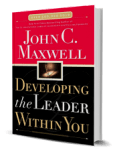
by Julia Felton | Aug 29, 2011
In my last post we learnt how focus and clarity helped “Susan” when she was in the picadero with a horse. Today, I’d like to share some of the teachings of one of my other great mentors (apart from my horses) in the art of leadership, John C Maxwell. For some years now I’ve been in the habit of revisiting books that had a profound impact on my thinking. It’s a powerful process, I find new insights and understandings I hadn’t experienced before, not because there’s been any change in the content of the book of course, but because of the changes in me since I first read the book. My awareness has shifted, resulting in my ability to see things in the book I wasn’t able to see previously.
Recently, I returned to John’s ‘Developing the Leader Within You’, and one of it’s messages hit me like a train. It was a message relating to vision, perception, thinking and potential.
Casting vision ignites potential. Too many people fail to create a compelling vision for what they aspire to in their lives, and what can’t be seen with the mind can’t be created in life. What you see is what you can be, and what you see is what you get.
I’ve worked with many business leaders who cast vision for their business and never for themselves. This is a major error. Without a personal vision of success, an individual is nothing more than a wondering generality in life.
Having a career is one thing, shaping one on your own terms is another. Lacking vision, a person is a like a ship adrift at sea without destination, it’s the tide that governs the path. Despite the biblical warning of ‘where there is no vision the people perish’ many people are still choosing to live life this way.
Then there’s perception. The way a person chooses to see things has a massive impact on their success in life. Konrad Adenauer once said ‘we all live under the same sky, but we don’t all have the same horizon’.
Henry Ford was told repetitively by his most senior engineers that his idea to create an eight-cylinder automotive engine was ‘impossible’. Over a two year period he continually sent them away to ‘make it so’, only for them to return with the same message. He refused to accept their beliefs, and eventually they overcame the obstacles and ‘made it so’. Ford and his engineers lived under the same sky yet had very different horizons.
What you see is what you get. What are your horizons? Where’s your thinking?

by Julia Felton | Jul 13, 2011
There is so much that horses can teach us about life. Horses have been described as “authenticity meters” and in my experience this is so true. They see beyond the mask that we put on and through to the real core of the person. They know when someone is frightened or in need of support, and when someone is overly aggressive. Horses allow, and expect us, to be who we truly are. They will not tolerate the mask that humans so often feel forced to put on in order to protect themselves.
I am reminded of an experience with a young lad, we shall call him Tom. Tom had been excluded from school for his aggressive behaviour. The teachers described him as being out of control and he bullied the other children. It took only a few sessions with a horse for Tom to realise that in order to connect with a horse he needed to let go of this mask. He needed to expose the young, frightened lad beneath and know that everything would be alright. Tom learnt it was ok to show his emotions and soon realised that acting tough had not been serving him well.
Horses act as mirrors reflecting back to us what we otherwise choose not to see. We all understand that we have different perspectives on the world and see the same thing in different ways, yet ironically we can only see what we already have in our frame of reference. If we experience the horse as angry and aggressive, it is likely that there are similar emotions that we have running through our lives. Horses allow us the opportunity to experience firsthand what is happening to us and by providing immediate feedback they allow us to change our actions to get a different result. How often does that happen in life? And importantly horses are non-judgemental. They just respond to the energy and intent shown to them. For children, I have found that often when faced with a horse the child’s whole persona can change as the real child that has been hiding behind that conditioned mask emerges. This can be a joyous experience for both children and parents. AHA! Moments occur and the children, and parents, get some real insights into what is happening for them.
So why is Horse Assisted Coaching so powerful? Well the answer lies in the fact that many traditional programmes focus on a verbal, classroom (neo-cortex) approach. Whilst this clearly has a role in society I have found that Horse Assisted Coaching sessions achieve a deeper, more sustainable and faster impact on creating change. This is achieved by doing, what is known as limbic learning, therefore there is no integration required. Examples of limbic learning are riding a bike, learning to walk etc. Once we have learnt to do these we do not forget.
Typically no riding is involved in a Horse Assisted Coaching session. Generally, all the work is done on the ground with the participants leading the horses through a series of exercises that help give them insight into such diverse topics as:
- The importance of being a great leader. If you can’t lead a horse and get him to follow you, how can you expect a team to follow you? Importantly, how can you lead others if you can’t lead yourself
- How body language and voice tonality help you influence others. With no words participants need to influence the horse to move using their own resources and what state you are in definitely influences the outcome.
- Value of teamwork. In this ever-connected society there is a real need for being plugged into the system in order to succeed. Alliances and partnerships will become more commonplace so participants learn how to contribute to a team and work towards a common goal.
- The importance of focus and intent because if you are not clearly focused and know what you are doing then horse will not follow you.
Sessions can be run in a group format or one on one depending on the client’s requirements. Horses can also be used to develop family constellations and these in the past have been shown to be very powerful.
So if you are looking for a fun, innovative way to have a break through with your clients then please do not hesitate to contact me. connect@connect-thru-horses.com
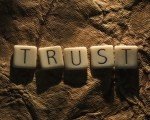
by Julia Felton | Jun 27, 2011
Horses, like people, are seeking trusting relationships and none more so than my young fillies Thistle and Bracken. New to the world they are finding their way and learning how to trust. I therefore found this article by Stephen M. R. Covey on the Speed of Trust really insightful in helping me think about how to build trust with my ponies. The principles work for any relationship.
Have you ever trusted someone–and gotten “burned?” Have you ever failed to trust someone and missed significant opportunities as a result? The practical issues with regard to extending trust are these: How do you know when to trust somebody? And how can you extend trust to people in ways that create rich rewards without taking inordinate risk?
When you’re dealing with trust, it seems there are two extremes. On one end of the spectrum, people don’t trust enough. They’re suspicious. They hold things close to the vest. Often, the only people they really trust are themselves. On the other end, people are too trusting. They’re totally gullible. They believe anyone, trust everyone. They have a simplistic, naive view of the world, and they don’t even really think (except superficially) about the need to protect their interests.
Extending trust can bring great results. It also creates the possibility of significant risk. The decision to trust or not to trust is always an issue of managing risk and return. So how do you hit the “sweet spot?” How do you extend trust in a way that maximizes the dividends and minimizes the risk?
Life is filled with risk. However, as noted historian and law professor Stephen Carter has observed: “Civility has two parts: generosity when it is costly, and trust, even when there is risk.” The objective, then, is not to avoid risk. In the first place, you can’t; and in the second place, you wouldn’t want to because risk taking is an essential part of life and leadership. Instead, the objective is to manage risk wisely–to extend trust in a way that will avoid the “taxes” and create the greatest “dividends” over time.
Learning how to extend what I call “Smart Trust” is a function of two factors–your propensity to trust and your analysis. “Propensity to trust” is primarily a matter of the heart. It’s the tendency, inclination, or predisposition to believe that people are worthy of trust and a desire to extend it to them freely. “Analysis” is primarily a matter of the mind. It’s the ability to analyze, evaluate, theorize, consider implications and possibilities, and come up with logical decisions and solutions.
As you think about these two factors–“propensity to trust” and “analysis”–how would you rate yourself on each? Do you typically tend to trust people easily–or do you tend to be suspicious and hold things close? Do you tend to analyze, theorize, and ponder over things–or do you give problems your cursory attention and then move on?
While extending trust to other people always brings with it some risk, the often greater risk that’s frequently ignored is what happens when managers don’t extend trust to others. These managers usually incur much larger taxes than they think–including bureaucracy, politics, disengagement, and turnover–and they often lose the dividends that flow from extending trust, such as innovation, collaboration, partnering and loyalty. Sadly, their suspicion sometimes even helps produce the very behaviors they fear, which further validates their suspicion. By treating people as if they can’t be trusted, they help to create a collusive, downward cycle of distrust. And this is one reason why–in this “flat world” global economy–not trusting people is often the greatest risk of all.
With regard to “propensity to trust,” I once knew a business owner who was so suspicious that his employees might be stealing from him, that he would literally interrogate them almost daily. He would even do occasional spot “frisk checks” when they left the office. This man was convinced that people were trying to steal from him. In reality, no one was, but his suspicious actions drove away his most talented people who wouldn’t tolerate working in such a distrustful environment or for such a suspicious boss.
With regard to “analysis,” it’s helpful to consider three vital variables, which you can do by asking these questions:
1. What is the opportunity (the situation or task at hand)?
2. What is the risk involved? (Possible outcomes? Likelihood of outcomes? Importance of outcomes?)
3. What is the credibility (character and competence) of the people involved?
Smart Trust doesn’t mean that you extend trust to everyone. Based on the circumstances, your judgment may be to not extend trust or to extend only a limited measure of trust. In extending trust, the general guideline is to extend trust conditionally to those who are earning it and abundantly to those who have already done so. Keep in mind that even when you extend trust abundantly, there should still always be clear expectations and accountability because those are principles that actually enhance trust.
I affirm that in our “flat world” economy, the ability to establish, grow, extend, and restore trust is the key professional and personal competency of our time. And the ability to exercise Smart Trust is a vital part of that competency. It will enable you to create a powerful balance and synergy between analysis and the propensity to trust, which, in turn, will produce the judgment that enables you to effectively leverage yourself and to inspire the talent, creativity, synergy, and highest contribution of others.
Note: The preceding article is based on the book, The Speed of Trust, by Stephen M. R. Covey.
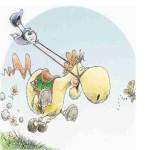
by Julia Felton | Jun 20, 2011
This week’s blog is inspired by Mark Fritz and his weekly quotes in leadership. Recently Mark stated:
“Leadership is influence, and the consistency of our behaviours is what keeps our influence with others high. However, the hardest person to influence is ourselves, as we often ask ourselves “Why am I not able to do it?”. Successful leaders understand that the foundation of their success is built by leading themselves first”.
This statement really made me think as I resonated with it so much. Horses are always looking for a leader to take care of them. Let’s face it being a leader is tough, and few want to do it when others are willing to assume that mantel. However, what is really interesting is that whilst a horse is happy to be a follower he will only remain in that role if he knows the leader is competent and making sound decisions. The minute the leader demonstrates poor decision making and acts in an indecisive way, the horse is forced to take over the leadership role in order to keep himself safe.
This has so many implications for organisations as unlike my horses, employees in organisations cannot assume the leadership role if their boss lacks leadership style. Rather they are forced to stay and keep on operating in the same way, despite the fact they are aware of serious leadership flaws. This made me wonder how those employees feel. I suspect they lack trust in their leader and in fact often get disheartened believing that they could do a better job. How demoralising and demotivating that must be.
The Peter Principle states that:
“We are promoted to our level of incompetence”
So given this fact there must be an awful lot of leaders in business today that are not really happy in that role. In my opinion these “uncomfortable” leaders often lack the charisma and ability to earn respect and instil trust in their teams. What a tragedy this is and for what it is worth in my view many of these people lack these essential management skills as they can’t apply them to their own lives. In my observations of successful leaders these are the ones that have a real focus, desire and passion. They know what they want in their lives and this drive is infectious. It rallies people to support them and as such their tribe grows and grows. They lead by example with passion and committment. They understand that real leaders can’t lead others until they can lead themselves.
Are you leading yourself, the hardest person, or are you letting life lead you. Leadership is not for the faint-hearted. Step up to the mark and claim your power and get a tribe of people following you. Just like my horses want to follow me.
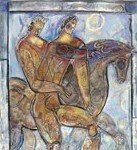
by Julia Felton | May 25, 2011
The way I see it, women approach leadership and horses a lot differently than men do. As children in our imaginary games riding Pegasus, Pegasus reads our minds and takes us to enchanted places. Girls are attracted to Pegasus from their desire to experience a magical connection through a magical ride; while boys grab their broomstick, and ride to a destination that they tell their imaginary horse to go.
My method address horses more like a woman of course because I am wanting a relationship with a horse more than any service I might get from the horse. The service I do receive from the horse is a way to enjoy our connection from a co creative process. It turned out that in competition, my method could hold up to any other method that was not interested in developing a friendship from the training process.
I have seen methods that are driven by a dominant approach through a masculine energy develop friendship with a horse, but the horse had to give up the ability to say “no,” or the power to change the subject, or have any say in the matter of his training at all. The masculine intent was not to abuse the horse in the best of circumstances, but never considered the relationship with a horse as a love interest that women do.
This caused a lot of woman to become unsatisfied with how horse training methods were applied to horses. The fact was that there was no choice in the matter if you were the horse.
It did not satisfy me. I see the treatment of horses to be abusive even in the nicest approach. The reason is that the method is brought to the horse whether the horse wanted it or not.
Masculine energy uses directive leadership and feminine energy uses supportive leadership. Women prefer not to get involved with leadership if they can help it, which is too bad because women are very good in the leadership role if they give their self half a chance.
Women understand something that men still need to consider- and that is leading a horse is part of a co creative process. They also believe that this co creative process is capable of producing the best performance. And that for leadership to really work out- you will need to follow your horse more than you will be leading him in the beginning to create a bond and a willing partner. Once you get this done, a horse will do just about anything for you without a lot of manipulation to get him to do it.
Where women fail to connect with a horse is created from their not understanding how to set up clear boundaries. It is a puzzle piece that is the missing ingredient in feminine energy. A woman has a tendency not to know when to allow, when not to allow, what to allow, what not to allow -and that to gain leadership and respect, boundaries must be flexible to be able to train the horse to have a desire to follow your lead over his own. How I do this through my Waterhole Rituals is by empowering a woman through many activities surrounding intimate interactions with a horse because that is when women are most comfortable. We are all about the bond and the heart felt connection. After we have made this connection, we can do just about anything -just from our natural instincts as supportive partners which comes very naturally to us.
When a woman learns how to gain leadership from using flexible boundaries she finds that leadership isn’t something she needs to demand from a horse. Once the boundaries are understood, horses have a strong desire to naturally follow your lead. This is very simple really. This is achieved from the horse working around your wants and needs that take place in regards to you personal space, and how you are feeling in the moment. Horses and women know how to work around each others needs in a partnership.
I have seen that when a woman learns that she is solely responsible for her own personal control of her personal space that all of a sudden, she sees how to use this way of being into her relationships in her life, and in affairs of the heart. She begins to turn the table on her life, and receive more respect and better treatment in all relationships. It is just a small puzzle piece we need to gain.
Masculine and Feminine and Vice Versa
In human beings there is both male and female energy. To really have the optimum dance with a horse requires that those energies are in balance, and used in a positive way. Both energies need to work at the appropriate times supporting each other in leadership. A horse needs a much higher percentage of female energy than male energy. However, as the relationship grows to a fine art of dancing, male energy creates the ultimate dance when the desire to be led, and to dance is the complete focus of the horse.
In Closing
We are all puzzle pieces and we need each other to be fulfilled. I believe what I have to offer is strengthening feminine empowerment through feminine leadership by giving women the ability to know what to allow and what not to allow, when to allow and when not to allow. Women by their nature are missing this puzzle piece to be truly empowered in the world of business and affairs of the heart. A woman’s power lies in their innate knowledge that leaders must follow the follower more than the follower ever needs to follow the leader in order to reach harmony in a working partnership.
There is a formula to a working partnership where both male and female energy create the perfect world. My understanding is that the map that you follow is the formula to achieving your goals. There are patterns to be followed that lead to goals. These patterns are thrown out because of people wanting short cuts. Our journey needs to always be a study and lessons of our personal growth as we are reaching for our goals. This way, the journey stays sacred, and our ethics and morals and our heart are not destroyed by the goals that we set for ourselves. We are now out of balance. We now are aware that we are. Horses show us where fairness lies and guide us to our strengths and our missing parts and show us how to obtain our goals for the ultimate connection we are longing to achieve when we give them freedom to be who they are to lead us there.
Posted by my equine mentor Carolyn Resnick on www.carolynresnickblog.com

by Julia Felton | Mar 6, 2011
You know when you hear something more than once in a few days you really should check in it, well that’s just happened to me. On Thursday at the Academy of Chief Executives Mark Fritz was talking to us About the Power of Ownership in Leading Across Distances and Cultures and during his amazing seminar he told us we should check out a TED video by Simon Sinek on Leadership. Then I find out my friend Jezz Moore, from Moon Cow, has tweeted the same thing. Synchronicity working or what, but given I’ve been hit with with twice in as many days I felt compelled to watch the video. You can see it here at:
http://www.ted.com/talks/simon_sinek_how_great_leaders_inspire_action.html
What inspired me most about this video was the fact that we all need to begin with our WHY. For the last few years I’ve been told by many mentors and coaches that WHY is the most important thing. When you are clear on your WHY then all subsequent actions like HOW and WHEN will fall into place. Personally, I’ve been struggling to find my WHY – although day by day it becomes clearer. One of my coaches has told me that reason for my inaction is that WHY is not strong enough. One thing that I have observed is that many of the great teachers and successful business people in this world have really strong WHY’s, in many cases driven from a state of despair due to financial ruin or serious health concerns. I find it kind of sad that it takes a serious personal experience for people to become clear on what their WHY is. Surely we don’t need to all reach these depths of despair to be successful.?
What Simon Sinek so clearly articulates in this video is the Golden Circle that starts at the centre with WHY, then contains another concentric circle with HOW and finally a concentric circle with WHAT.

Sinek suggests that really successful organisations and people (such as Apple) start with their WHY. They inspire others to do business with them because they have the same beliefs. Apple do not pitch their advertising based on WHAT they do but rather WHY they do it. This is why they can sell computers, phones and music and no-one doubts the authenticity of the company. Compare this to Dell who like many other companies focus their advertising strategy of the WHAT. Dell make computers and now we are so embedded with the fact that this there is core competency that we can’t conceive of purchasing same a phone or and MP3 player from them.
Furthermore Sinek goes on to explain that purchasing decisions are based on biology not psychology and that the WHAT appeals to the neo-cortex of the brain which controls rational thought whereas the WHY and HOW align with the limbic system The limbic system is concerned with trust and loyalty and decision-making that drives behaviour. So by appealing to a consumers WHY you instantly put them in a place where the buying decision can be influenced by the limbic brain.
So how does this lead onto today’s lesson from the horses. It is just that when a horses meets you he is asking three things:
- who are you
- what do you want; and
- how do you operate.
In this way he is concerned with what is happening in our limbic brain. A horse is also always looking to us to determine our ability to lead. Are we trustworthy and reliable? From this state of why the horse can quickly make that decision on how best to interact with us. Maybe this is why horses are so good as Teachers. They make sure we stay out of our thinking, rational neo-cortex brain and force us to be congruent with who we really are. They challenge our WHY and who we think we are. Invariably in coaching sessions clients have AHA experiences as they realise who they thought they were and how they are acting are incompatible. Horses challenge our WHY are therefore our integrity and congruence and since they are non-judgemental they just feed back what they experience. It can be an eye-opening experience for most people.
So for today spend some time considering what is your WHY. Why are you on this earth and what is your purpose in life. If you need some help here some great resources that I have found really helpful are The Passion Test by Chris and Janet Attwood and Success DNA Detector which can be found on http://www.authorityformula.com/
I’d love to hear your comments below on what your WHY is.

by Julia Felton | Feb 12, 2011
Todays blog has been inspired by one of my clients that I was coaching this week. Let’s call the client Susan. Well Susan had just had a big row with her partner and as a result was feeling sad and angry. She just wanted to left alone and so she decided to go for a walk. There was light drizzle in the air and she ambled around the farm that she called home. She could hear the bird song in the background as her mind replayed the argument in her head. She was upset by how she had let her boyfriend manipulate her again and make her feel unworthy.
Without thinking her walk ended up taking her to the field where her horses lived. Susan heart lifted at the sight of her horses grazing silently in the field. Part of her wanted to join their herd for the safety and security they brought and yet at the same time she felt anxious about letting her horses see her when she was in this emotional state. Susan had always been taught that she needed to be strong around her horses and display strong leadership. She did not want to bring them the negative energy that she was experiencing and yet her feet drew her into the field. She climbed the fence and then found a log and sat down, sharing territory with her horses, something she had done many times before.
For two weeks Susan had been sharing territory with her horses and they had just ignored her. They acknowledged her presence as she entered the field but just kept themselves to themselves, grazing quietly and never interacting with her. However, today things were very different. After ten minutes her trusted elder horse came over, totally unprompted, and just stood next to Susan. Susan said it was just as if the horse knew she needed support and was totally willing to be there for her with no expectation. For Susan the realisation came that she did not always need to be strong but could show vulnerability and that was fine.
Susan’s story touched me profoundly as I recalled how many times in the past I have put on that armour of bravery when in fact I was in need of help. I’ve seen this happen numerous times in the corporate world, particularly leaders, who often think they should have all the answers. Well the reality is that when we let out guard down and show people that as leaders we too are vulnerable we can drastically improve our likeability to others. Somehow we are no longer aloof, we become approachable human-beings and this helps us form connections with others.
So my thought for today is that if you are feeling vulnerable do not think that this is necessarily a sign of weakness. Share your concerns and fears and you might be amazed at the level of support that you will receive. As always I’d love to hear your comments.

